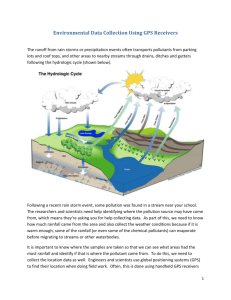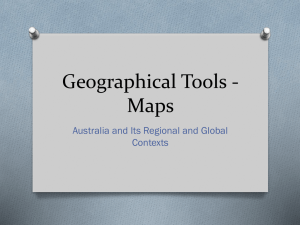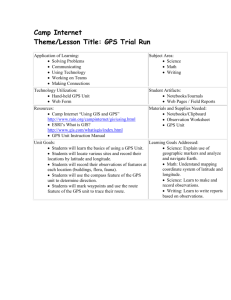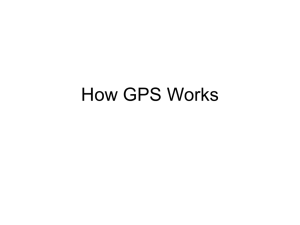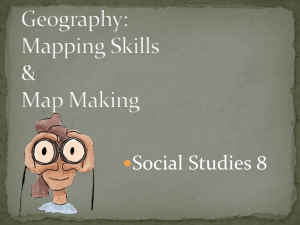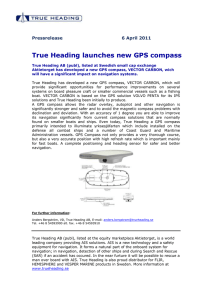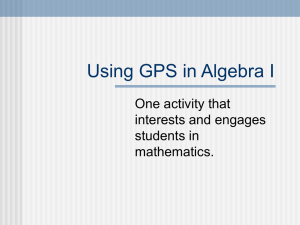1 Marine Charts and Navigation
advertisement
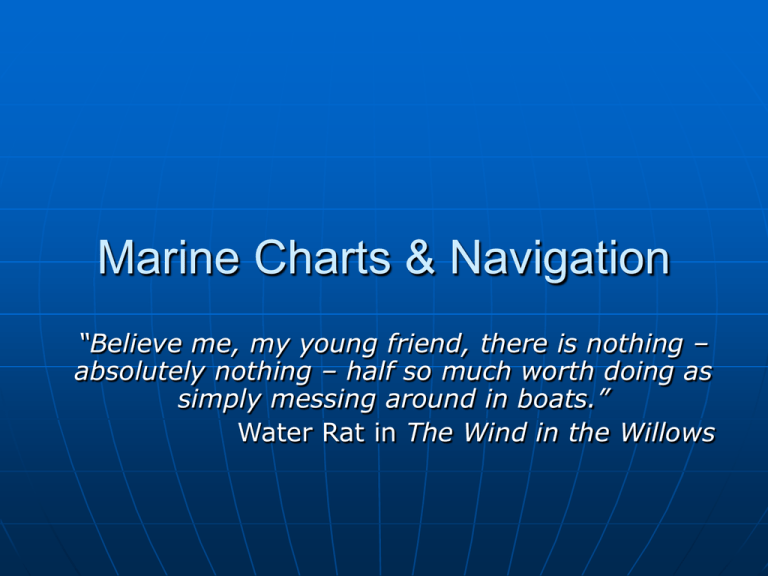
Marine Charts & Navigation “Believe me, my young friend, there is nothing – absolutely nothing – half so much worth doing as simply messing around in boats.” Water Rat in The Wind in the Willows Background Charting US coastal waters began in 1807 • Office of Coast Survey (OCS) Oldest Scientific Organization in the US Part of the National Ocean Service Navigation – the art and science of locating the position and plotting the course of a vessel • Where are You? • What direction do you need to head to get to where you want to be? • How far away is it and how long will it take to get there? • How do we maneuver to safely reach a desired destination? Modern Nautical Charts Graphical portrayal of the marine environment • • • • General configuration of the sea bottom Water depths Currents Locations of dangers to navigation (wreck, rocks, sandbars) • Information about aids to navigation (buoys, beacons, and conspicuous objects) Traditional Paper Charts and Electronic Formats • http://chartmaker.ncd.noaa.gov/staff/charts.htm • United States Coast Pilot Supplemental information • nowCOAST – map-based internet gateway to real-time observations and forecasts of marine weather and oceanographic conditions The Coordinates Meridians of Longitude • Set of circles that pass through the north and south poles • Prime Meridian - Reference point is the meridian passing through Greenwich, England. Represented by 0 degrees. • Measured by how many degrees east or west of PM (maximum is 180 degrees) Parallels of Latitude • Set of circles that would lie on plane surfaces cutting through the Earth perpendicular to the polar axis (perpendicular to meridians of longitude) • Equator is the reference point. • Measured by how many degrees north or south of the Equator Minutes and Seconds – fractions of degrees (60 minutes in one degree and 60 seconds in one minute) 1° latitude = 60 nautical miles (1' =1 NM) 1 Nautical mile = 1.15 Statute Mile (1 degree = 60 NM = 69 SM) Knot (speed used at sea) = 1 NM per hour • Useful conversion – D=RT D=Distance (in nautical miles) R=Rate (in knots) T=Time (in hours) Relationship between Longitude and Time 360 degrees in a circle 24 hrs in the circle that a person standing on the earth travels between noon one day and noon the next 360/24 hours = 15 degrees/hr 0 degrees is the starting point for time zones Local apparent noon is when the sun is directly overhead • Noon GMT = 0600 on DI (88/15=6hrs) • So if you know when the sun is directly overhead and the time in Greenwich, you can calculate longitude (the difference in time is distance) Evaluate Your Chart Locale Unit of Soundings (may be in Fathoms) Datum Plane - A permanently established horizontal plane, surface, or level to which soundings, ground elevations, water surface elevations, and tidal data are referred Date of the Survey Title Block Isobaths – connect similar depths Channels and Markers – Odd/Green, Even/Red Nature of the Bottom Obstructions Landmarks Compass Rose Shows clearly the equivalent magnetic and true north directions Magnetic North – to which the north-seeking pole of a magnetic compass points True North – geographic north Cardinal points - N(0º), E(90º), S(180º), W(270º) Intercardinal points – northeast, southeast, southwest, northwest Vocabulary Course – intended direction of travel (expressed in degrees). Wind, ocean currents and pilot error may change the ship’s course. Heading – actual direction of travel, regardless of course. Drift – deviation from course due to wind or current Bearing – direction from one point to another expressed as an angle from north Range – distance from one point to another Waypoint – point between legs of a route where direction is changed How to “fix” a vessel’s position on a chart Find the desired latitude on the scale on the sides of the chart and connect them. Note that the scales on the sides of the charts will be in minutes and seconds – not degrees! Do the same for longitude (top and bottom) Where the two lines cross will be the designated position How to determine distance Use a drafting compass or pair of dividers Spread the points so that they touch the ends of the length to be converted Transfer the points directly to the bar scale to obtain distance (or 1 minute = 1 NM) Use distance and bearing lines of position to fix position Within site of land: Technique 1: Take bearings with a compass on at least 2 landmarks and plot the lines on a chart The vessel is located where the two lines cross Technique 2: Use a range finder to get the distance to two land objects Draw circles with those radii The vessel is at the intersection of the arcs Beyond site of land: • • • • RDF – Radio direction finding Dead Reckoning – uses D=RT (difficult to account for drift) Loran – Long Range navigation GPS – Global Positioning System GPS Receiver computes the distance to a satellite based on amount of time required for a radio signal from the satellite to reach the receiver Based on Trilateration 24 Satellites – launched, operated and maintained by US Air Force Global Network of ground monitoring stations – precisely determined CORS (continuously operating GPS reference stations) – stationary and permanently operating receivers that receive GPS signals and transmit position data Deployment Constellation •21 Satellites (Plus 3 Operational Spares •55º Inclination •Repeating Ground Track •4 Satellites always in view Geocaching New generation of outdoor game – “treasure hunt” Use GPS receiver to navigate to the specific latitude and longitude of a hidden container www.geocaching.com Sample Questions Deploy a buoy 500 yards N of a platform at coordinates X in 54 ft of water. What are the coordinates of the buoy? (1nm=2027 yards) How long does it take to get there from DISL at 9 knots? How long does it take to get from 30º30’N to 30º40’N at 5 kts?



